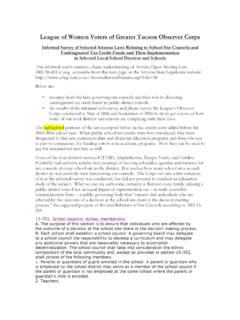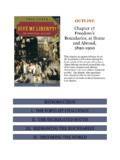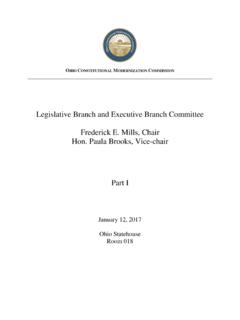Transcription of WATER USE AND WATER RIGHTS IN PENNSYLVANIA - …
1 WATER USE AND WATER RIGHTS IN PENNSYLVANIA A Status Report from the league of women Voters of PENNSYLVANIA Citizen Education Fund Common Ground Project on: " WATER Resources Management for PENNSYLVANIA s Future" 1998 league of women Voters of PENNSYLVANIA Citizen Education Fund Table of Contents Introduction .. WATER Law in PENNSYLVANIA .. Public Trust Doctrine Surface WATER vs. Groundwater RIGHTS Riparian Systems vs. Appropriative Systems Consumptive Use vs. Nonconsumptive Use Existing WATER Laws in PA Responsibility for Overseeing WATER Use in PA .. River Basin Commissions Department of Environmental Protection Fish and Boat Commission Other Agencies Problems/Gaps in PA s Riparian System.
2 WATER RIGHTS Guarantees Competing Uses WATER Demand WATER Conservation Droughts Options and Consequences .. Riparian, Prior Appropriation and Regulated Riparian Systems State and Regional Options Watershed-based WATER Supply Planning Model State WATER Code (eastern states) What Other States Are Doing No Change in Current PA System Future Demands for WATER Use in PA .. WATER RIGHTS and WATER Use a Top Priority .. Conclusions and Summary .. Appendix .. WATER USE AND WATER RIGHTS IN PENNSYLVANIA A Status Report from the league of women Voters-Citizen Education Fund Common Ground Project on: " WATER Resources Management for PENNSYLVANIA s Future Introduction In 1995 the LWVPA-CEF initiated a Common Ground Project on WATER Resources Management in PENNSYLVANIA .
3 The project brought together a broad range of stakeholders to assess the need for improving our laws and policies related to WATER use in the Commonwealth. Prior to a project conference in September 1995, eight work groups were formed to discuss and prepare reports on the following topics: Goals and Objectives of WATER Resources Management in PENNSYLVANIA Permitting and Registration of WATER Withdrawals Consumptive Use/Nonconsumptive Use and Drought Management Conservation and Efficient Use of WATER Instream Flow Needs Integration of All WATER Programs Federal, State & Local Interbasin/Interstate Transfers and WATER Supply Planning for Future Needs WATER Resources and Land Use Planning The "Pre-Conference Report" and a "Summary of the Conference Proceedings" are available from LWVPA-CEF. Following the conference several regional meetings were held to gather viewpoints about the needs of differing geographical areas: the Upper & Lower Susquehanna Basins the Upper & Lower Delaware Basins This paper is an update on developments in WATER policy on the state and regional level since 1995.
4 One of the most significant has been the promotion of a watershed approach to WATER quality and quantity management by both EPA and DEP. There is renewed interest in watersheds at local levels as evidenced by the formation of new watershed organizations and the growth of volunteer WATER quality monitoring to supplement monitoring done by agencies. The need for integration of WATER policies, programs and plans is becoming more evident as more accurate assessments of needs and future demands are made known. WATER Law in PENNSYLVANIA Public Trust Doctrine The Constitution of the Commonwealth of PENNSYLVANIA , Article I, Section 27 states, " PENNSYLVANIA s public natural resources are the common property of all the people, including generations yet to come. As trustee of these resources, the Commonwealth shall conserve and maintain them for the benefit of all the people." The adoption of Article I, Section 27, the Environmental RIGHTS Amendment to the PA Constitution, in 1971 represents the culmination of a major change in attitude about the use and exploitation of natural resources.
5 At the time the Commonwealth was founded, natural resources were abundant and seemingly inexhaustible. After two hundred years of population growth and industrial development, it became evident that unrestricted use of natural resources, while creating wealth and prosperity for some, had created many problems and environmental damage that would adversely affect future generations. The Environmental Amendment makes it clear that the Commonwealth is the trustee of PENNSYLVANIA s public natural resources and must conserve them for the benefit of all the people. WATER is a public natural resource that is required for the life and health of every person, a "vital resource." The "waters of the Commonwealth" are held in public trust by the Commonwealth. The right to "use" those waters is 1 conferred by the state through a common law system of riparian RIGHTS . There are rules covering different classifications of waters and WATER use in PENNSYLVANIA : Surface WATER vs.
6 Groundwater RIGHTS Riparian Doctrine for the use of WATER in streams: Each landowner adjacent to a stream can withdraw unlimited amounts of WATER for domestic use and reasonable extraordinary use on the property. Use of the WATER off the riparian property is considered "unreasonable per se." American Rule for withdrawal of groundwater: A landowner can withdraw percolating groundwater for natural and ordinary uses on that land regardless of effect on neighbors. There is no security of WATER RIGHTS under such a principle, , "the deepest well and the most powerful pump wins." Municipal WATER Supplies: Riparian common law views transfer of WATER as "unreasonable per se." However, court decisions have said that municipalities should not be prohibited from withdrawing WATER from outside their boundaries, but replacement of supplies affected by that withdrawal may be required. Riparian vs Prior Appropriation Systems Most of the states east of the Mississippi River have riparian systems of WATER RIGHTS based on English common law, interpreted and modified by court decisions.
7 Historically, under common law, riparian doctrine said that unlimited reasonable use on the property was allowed, but that any use off the property was considered unreasonable per se. Over time the courts have modified their interpretation to allow for certain non-riparian uses such as public WATER supply. Riparian systems recognize that WATER resources are to be shared, but there is no guarantee of a certain share. In states west of the Mississippi (which were established later) WATER was more scarce and WATER RIGHTS associated with land holdings were appropriated to the first settlers. Under prior appropriation statutes there is no requirement to share the resource. "First in time means first in line." Consumptive Use vs. Non-consumptive Use Most WATER uses in PENNSYLVANIA are non-consumptive, because the WATER is returned to the basin of origin after use. If WATER use results in evaporation, incorporation into a product, or diversion out of a WATER basin, it is considered consumptive use.
8 WATER Use in PA There is no comprehensive WATER management system in PENNSYLVANIA . Certain aspects of WATER use are regulated by the following agencies. River Basin Commissions: The Susquehanna River Basin Commission (SRBC) and the Delaware River Basin Commission (DRBC) grant WATER allocation permits for withdrawals of surface or groundwater greater than 100,000 gallons per day (GPD). In addition, the DRBC requires permits for withdrawals greater than 10,000 GPD in Groundwater Protection Areas. These two river basin commissions are unique in the United States for possessing this regulatory authority. They also have "consumptive use" rules that require reduction in consumptive use of WATER during droughts or payment of fees to provide storage in reservoirs for release during low flows. The SRBC and DRBC also monitor WATER flow in relation to drought conditions or flood potential and inform the state authorities when drought warnings and emergencies are to be declared.
9 Other functions of the commissions include WATER quality monitoring and mediation of disputes related to WATER use.. The Department of Environmental Protection Bureau of WATER Supply Management grants allocation permits to public WATER systems that use surface WATER , which account for about 10% of all withdrawals. 2 DEP also grants permits for the wells or springs of bottled or bulk WATER producers. The PA Fish and Boat Commission monitors the effects of proposed withdrawals on stream flows and aquatic habitats. The Fish & Wildlife Service also monitors stream flows and habitats. Other Agencies impact WATER quantity and contribute data. The Geological Service (USGS) monitors stream flows at permanent monitoring stations. USGS provided base flow analyses for the Neshaminy Creek Watershed in the Delaware River Basin Groundwater Protection Area. The Army Corps of Engineers maintains reservoirs for WATER storage to be released in times of low flows.
10 In the Ohio River Basin the Corps of Engineers also controls WATER levels in navigable rivers. Other agencies which influence WATER quantity include the Environmental Protection Agency, the Natural Resources and Conservation Service (NRCS), the Federal Energy Regulatory Commission (FERC)), the National Oceanic and Aerospace Administration (NOAA), the Forest Service, and the federal and state Offices of Mining. Problems/Gaps in PA s Riparian System The LWVPA CEF Common Ground Project on WATER Resources Management identified a number of problems with PENNSYLVANIA s current system of management, and potential problems for the future: No guarantee of WATER RIGHTS continuing undiminished No provision for resolution (other than litigation) of competing uses No provision for increased per capita demand for WATER No provision for conservation of WATER No provision for dealing with increase of conflicts during droughts Because PENNSYLVANIA has no comprehensive WATER management statute, the interstate SRBC and DRBC have the responsibility of making decisions about WATER withdrawals within the Commonwealth of PENNSYLVANIA .




